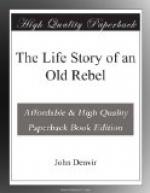Later still, I carried out a similar transformation with another of my own productions. I have a piece in three acts which, as a play, has never been published or performed. It is called “The Curse of Columbkille.” This drama I changed into a story, which has appeared in the series of 6d. novels published by Messrs. Sealy, Bryers and Walker. The most striking character in it is Olaf, a Dane, who believes himself to be a re-incarnation of one of the old Danish sea rovers. A member of the firm, the late Mr. George Bryers, a sterling Irishman, called my attention to the opinion of the professional reader to the firm that it would be advisable to call the story “Olaf the Dane; or the Curse of Columbkille.” I accepted the suggestion, and accordingly the book has been published with that title.
I have seen with much interest the movement inaugurated by the Irish Theatre Company in Dublin, and have been present at some of their performances in London. In spite of some false starts and a tendency to imitate certain undesirable foreign influences, the movement should certainly help to foster the Irish drama.
CHAPTER XXIV.
“HOW IS OLD IRELAND AND HOW DOES SHE STAND?”
Summing up these pages, how shall I answer the question asked by Napper Tandy in “The Wearin’ of the Green” over a hundred years ago—“How is old Ireland, and how does she stand?”
Let us see what changes, for the better or for the worse, there have been during the period—nearly seventy years—covered by these recollections.
Catholic Emancipation had, five years before I was born, allowed our people to raise their voices, and give their votes through their representatives in an alien Parliament.
I am not one to say that no benefit for Ireland has arisen through legislation at Westminster, but the system that allowed our people to perish of starvation has always been, to my mind, the one great justification for our struggle for self-government by every practicable method. It has been a struggle for sheer existence.
If Ireland had had the making of her own laws when the potato crop failed, not a single human being would have perished from starvation. That I am justified in introducing the terrible Irish Famine and its consequences into these recollections as part of my own experiences I think I have shown in my description of its effects upon our people when passing through Liverpool as emigrants or as settlers in England.




